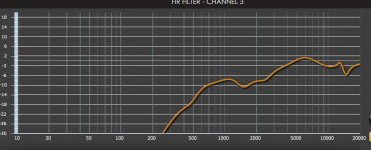Great idea with the self damping mounting method!
Funnily enough I used tupperware for my rear chamber as well! - I think about 600ml though.
Have the measurements improved with your improved throat geometry?
Funnily enough I used tupperware for my rear chamber as well! - I think about 600ml though.
Have the measurements improved with your improved throat geometry?
Agree tuk182 and bushmeister that Rokytheman did some great cool work there and shared pictures thanks for that.
thank you all 🙂
bushmeister: I got the idea for the box from one of your posts. Would have liked a smaller box - But I think it looks quite nice. Maybe I will make some kind of sock/net to put around it.
Im not sure the measurements have improved much with the bigger throat. Maybe this has to do with the fact that the new routerbit did not make the diameter much bigger - Only the rounding.
I tried with some thin felt between the wool ring and the horn. One with a smaller ring than the other - So two different sizes. The felt ring seem to "only" mess up the response a little bit. Around 5.1 K. - I did not glue it to the horn.
Im not done with the tuning/EQ'ing yet, but the horizontal polar response looks quite good, right? Distance around 120 cm. Maybe I will add a notch around 1.8 Khz.
Also attached a illustration of the actual EQ'ing at the moment. Crossover LR48 dB at 600 Hz.
bushmeister: I got the idea for the box from one of your posts. Would have liked a smaller box - But I think it looks quite nice. Maybe I will make some kind of sock/net to put around it.
Im not sure the measurements have improved much with the bigger throat. Maybe this has to do with the fact that the new routerbit did not make the diameter much bigger - Only the rounding.
I tried with some thin felt between the wool ring and the horn. One with a smaller ring than the other - So two different sizes. The felt ring seem to "only" mess up the response a little bit. Around 5.1 K. - I did not glue it to the horn.
Im not done with the tuning/EQ'ing yet, but the horizontal polar response looks quite good, right? Distance around 120 cm. Maybe I will add a notch around 1.8 Khz.
Also attached a illustration of the actual EQ'ing at the moment. Crossover LR48 dB at 600 Hz.
Attachments
Nice work there Rokytheman! I like the suspension rubber bands to hold it in place. Btw, some members have been using these "Sports Pylons" as rear chambers instead of a Dagger. I have heard good reports. I bought a set myself and the plastic is a rather thick semi pliable heavy plastic - not stiff and resonant at all. It even has 4 mounting holes and holds a 3.5in 10F/8424. I am told volume is 1.2 liters. These are 9in tall, I think they sell 7in ones too. I bet stuffed with polyfill or fiberglass, they would be very nice rear chambers.
Amazon.com: 7 Inch Plastic Traffic Cones - 12 Pack of 7” Multipurpose Construction Theme Party Sports Activity Cones for Kids Outdoor and Indoor Gaming and Festive Events: Toys & Games

Amazon.com: 7 Inch Plastic Traffic Cones - 12 Pack of 7” Multipurpose Construction Theme Party Sports Activity Cones for Kids Outdoor and Indoor Gaming and Festive Events: Toys & Games

thank you all 🙂 ...
...Im not done with the tuning/EQ'ing yet, but the horizontal polar response looks quite good, right?
Dang. That's really nice.
Those polars look great and very very similar to mine!
I must admit to being a little surprised but in all this time you are the only other person besides me to put a SB65 in that horn!
I just think it is a really easy, cheap way to create a fantastic result!
See my distortion measurements at 100db to get a real surprise at how good this combination is! I was shocked when I first did this a few years ago!
I must admit to being a little surprised but in all this time you are the only other person besides me to put a SB65 in that horn!
I just think it is a really easy, cheap way to create a fantastic result!
See my distortion measurements at 100db to get a real surprise at how good this combination is! I was shocked when I first did this a few years ago!
XRK971: nice! Those Sports Pylons are also available at the UK Amazon - By far more cheaper for us in EU (I live in Denmark)
I have no prior experience with horn, but I really like how it sounds!
bushmeister: Agreed. I stumpled on this thread quite randomly - But when I saw your measurements, I just could stop thinking about trying it myself. I am also really surprised that no one else have posted their findings/experience with it.
If I understand it correct, the distortion plots is on pair with some of the best tweeters available today !
I am thinking about adding one pair of SB17 MFC 4 speakers as a midrange in my system - Which I have from and old 2-way. The SB PFC drivers does play nice in my cabinet - And can play low and quite loud with a Linkwitz Transform. But they sound a little "closed"/damped.
I have no prior experience with horn, but I really like how it sounds!
bushmeister: Agreed. I stumpled on this thread quite randomly - But when I saw your measurements, I just could stop thinking about trying it myself. I am also really surprised that no one else have posted their findings/experience with it.
If I understand it correct, the distortion plots is on pair with some of the best tweeters available today !
I am thinking about adding one pair of SB17 MFC 4 speakers as a midrange in my system - Which I have from and old 2-way. The SB PFC drivers does play nice in my cabinet - And can play low and quite loud with a Linkwitz Transform. But they sound a little "closed"/damped.
I think that the little extra energy around 3-5 Khz from my polar measurements is something that has to do with the geometry of the horn. For instance this review of the horn, shows a similar result:
Test Bench: Eighteen Sound ND3ST 1.4” Compression Driver
Test Bench: Eighteen Sound ND3ST 1.4” Compression Driver
@bushmeister, @Rokytheman, @bwaslo
Have never tried out feature myself but it looks bwaslo's OmniMic can be downloaded and used for free to create nice polar response graphs based on exports from REW, more info into this link http://www.diyaudio.com/forums/soft...m-3d-development-math-help-6.html#post5320244.
Have never tried out feature myself but it looks bwaslo's OmniMic can be downloaded and used for free to create nice polar response graphs based on exports from REW, more info into this link http://www.diyaudio.com/forums/soft...m-3d-development-math-help-6.html#post5320244.
Attachments
Omnimic is feature-limited without a licence. Polars fortunately work, also normalization, I have used it too!
You can set polars up to 180¤ and I didn't reach limit for number of measurements loaded. You just have to rename the files to get polars working. I set smoothing and IR gating in REW before exporting.
You can set polars up to 180¤ and I didn't reach limit for number of measurements loaded. You just have to rename the files to get polars working. I set smoothing and IR gating in REW before exporting.
Last edited:
That's a nice find - did not know OmniMic was free.
Hi X everything oke there?
I am busy with class d learning and start to make the hybrid, need a case design for it so look at it how to do.
later this year the circlotron get again from stalling.
5 level class D I did try, carrier is then multiplyed by four, in mine case 1.6Mhz.
how it does with the horns?.
regards
Attachments
That's a nice find - did not know OmniMic was free.
Some stuff in it doesn't work without the hardware mic attached (mostly things that should be obvious). Anything that needs the impulse response directly won't (since there's no way to import and process an external impulse response in OM at present). But a lot of the FRD postprocessing stuff does.
Ahh, the mic is the USB "Key" - slick. I already have a UMM-6 and a UMIK-1. I do love Xsim though - superb gift to the DIY community.
Thank you!
Did not know you were author of OmniMic. 🙂
Thank you!
Did not know you were author of OmniMic. 🙂
Hi, good work, nice thread.
Both variants (bushmeister and xrk971) have Active Crossover? Or xrk971 did passive?
Both variants (bushmeister and xrk971) have Active Crossover? Or xrk971 did passive?
I have several questions regarding the use of a fullrange driver in a horn, some of which I've asked before, but did not yet find an answer to then:
- Is there a benefit of using a 1.4" horn throat instead of 2"? A 2" horn would make the adapter much easier because you would need less adapting. Would it have a negative impact on the directivity of the high frequencies? Less efficient because less compression?
- Is there a benefit for using a 3D printed deeper adapter vs a simple modification of the horn throat itself? So smoother transition vs shorter distance to throat?
- Did anyone play with phase plugs inside of the 3D printed adapter?
- Is there a benefit of using a 1.4" horn throat instead of 2"? A 2" horn would make the adapter much easier because you would need less adapting. Would it have a negative impact on the directivity of the high frequencies? Less efficient because less compression?
- Is there a benefit for using a 3D printed deeper adapter vs a simple modification of the horn throat itself? So smoother transition vs shorter distance to throat?
- Did anyone play with phase plugs inside of the 3D printed adapter?
Hi, good work, nice thread.
Both variants (bushmeister and xrk971) have Active Crossover? Or xrk971 did passive?
Sorry, I was not following thread so missed your question - both Bushmeister and myself used miniDSP. Although, I think a passive XO is not unfeasible as may designs of Synergy type horns with passives have been shown. Here, with only a 2-way FAST, one might even be able to do a 1st order time-aligned transient perfect XO. I think Kees once time showed that a simple capacitor high pass on the mid-twee can level off of the falling response and act as a high pass at once on the Trynergy.
Is there a benefit of using a 1.4" horn throat instead of 2"? A 2" horn would make the adapter much easier because you would need less adapting. Would it have a negative impact on the directivity of the high frequencies? Less efficient because less compression?
I don't think using a 2in throat hurts directivity as that is function of horn waveguide shape. We used 1.4in because it fits the SB65WBAC25 driver well and keeps overall horn compact vs 2in.
Is there a benefit for using a 3D printed deeper adapter vs a simple modification of the horn throat itself? So smoother transition vs shorter distance to throat?
I think the printed adapter is easier to make and more consistent. Bushmeister showed that with Bondo and sandpaper, you can make it work quire well without 3d prints.
Did anyone play with phase plugs inside of the 3D printed adapter?
No, not in this thread.
I don't think using a 2in throat hurts directivity as that is function of horn waveguide shape. We used 1.4in because it fits the SB65WBAC25 driver well and keeps overall horn compact vs 2in.
So there will not be a directivity problem high up like you get with 2" compression drivers? Would a 2" horn give you less sensitivity because of less compression? Compactness I would not mind. A bigger horn can be loaded lower, so will hold directivity up to a lower frequency. So if it will not hurt upper treble, and sensitivity is also not impaired, and ones does not mind the larger horn, I'd argue that a 2" horn might possibly yield an even better result?
- Home
- Loudspeakers
- Multi-Way
- A Bookshelf Multi-Way Point-Source Horn




